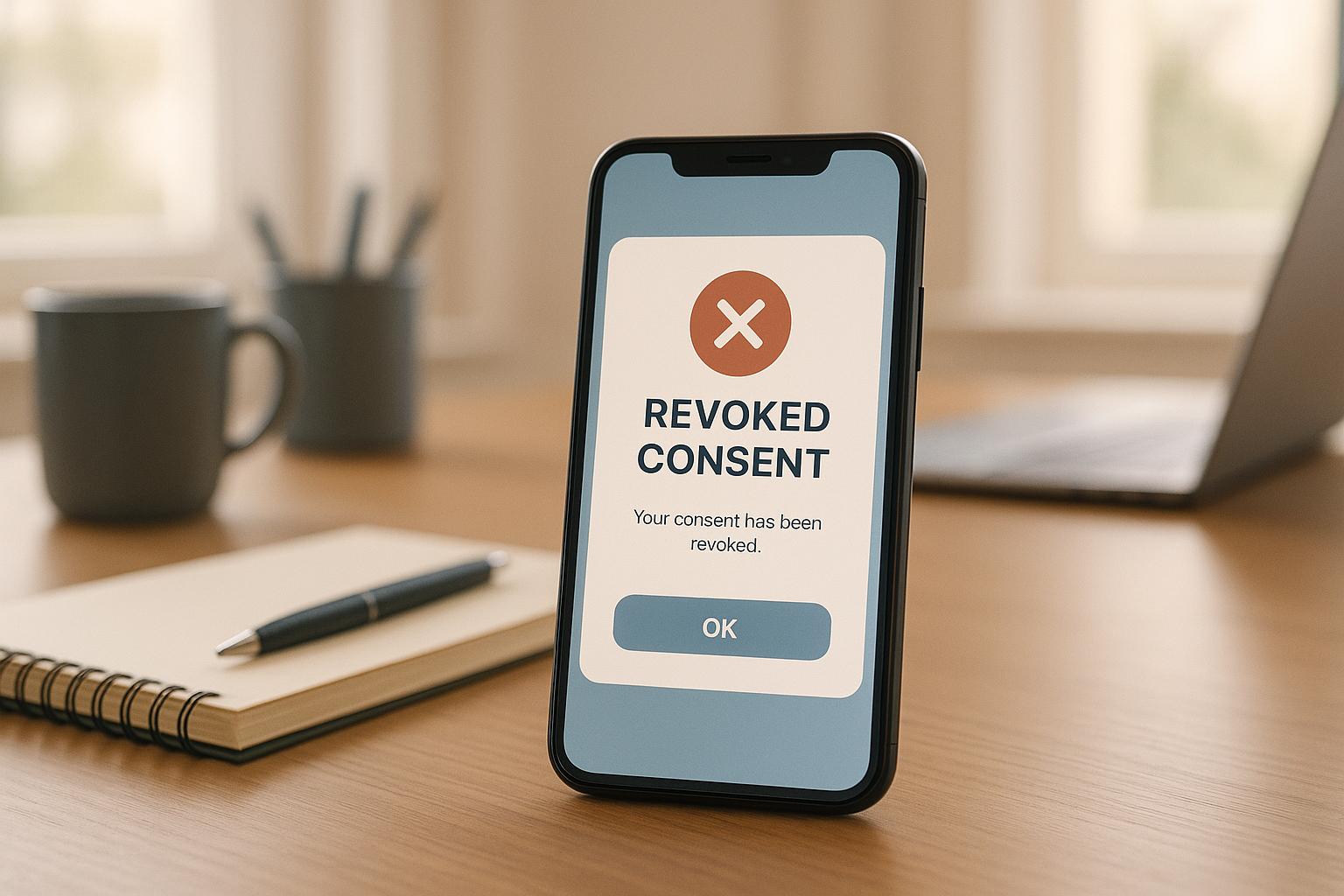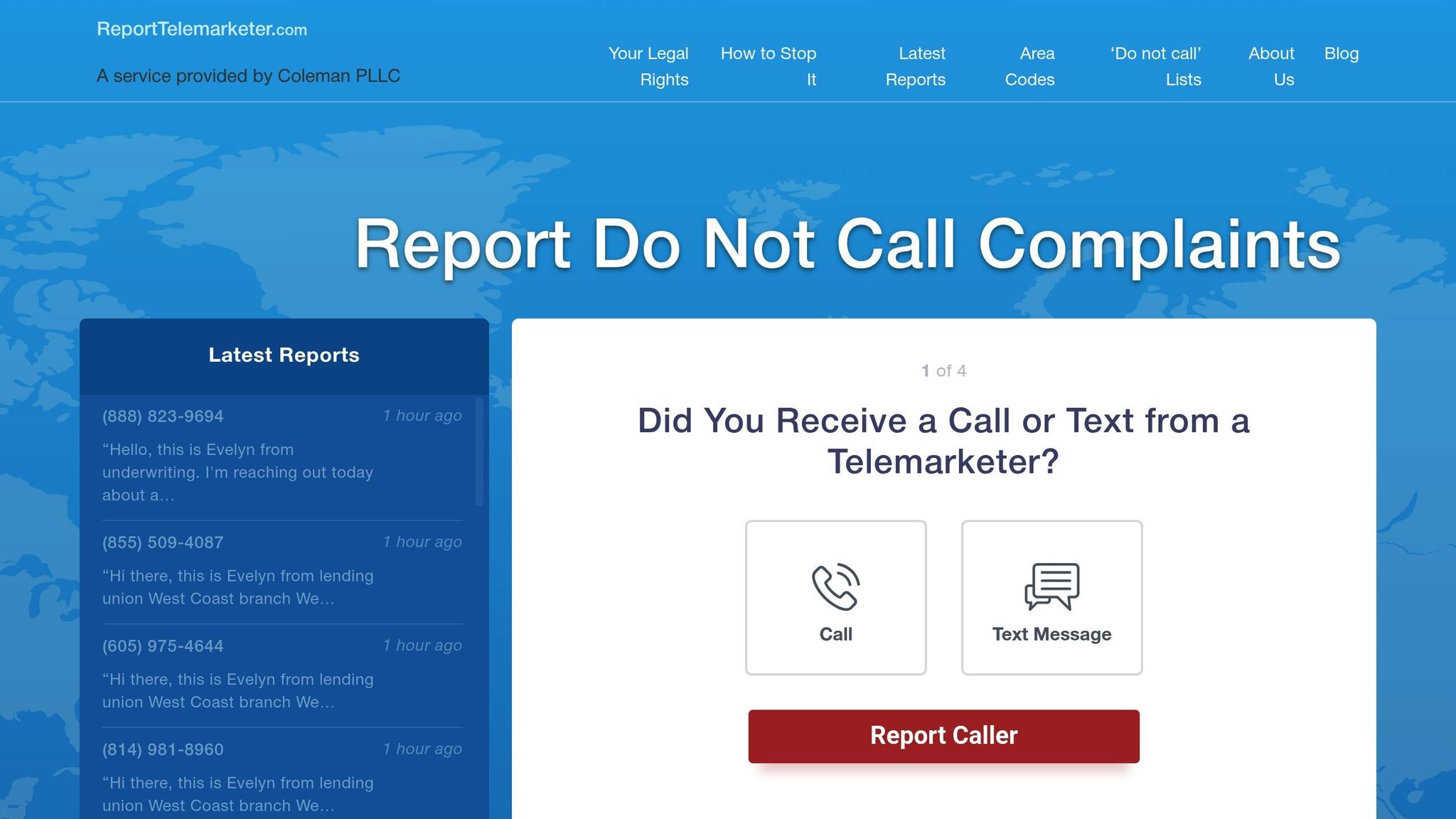
The FCC has introduced new rules for telemarketing consent revocation under the TCPA, starting April 11, 2025. These updates simplify how you can stop unwanted robocalls and texts while holding businesses accountable. Here’s what you need to know:
- Faster Opt-Out Processing: Telemarketers must stop contacting you within 10 business days (down from 30 days).
- Flexible Revocation Methods: You can opt out using any reasonable method (text, call, email, etc.).
- Standard Keywords: Words like "stop", "unsubscribe", and "cancel" must be recognized as opt-out requests.
- Confirmation Messages: Companies can send only one non-promotional confirmation text after you opt out.
- Stronger Enforcement: Businesses must prove that ignored opt-out requests were unreasonable or face fines of $500–$1,500 per violation.
These changes aim to give you more control over your communications and reduce the hassle of dealing with telemarketers.
How to Prepare for the April 2025 TCPA Consent Revocation Order | Convoso

What the 2025 FCC Consent Revocation Rules Include
The FCC’s updated framework for consent revocation makes it easier for consumers to take control of how businesses communicate with them. These changes directly address frustrations with drawn-out opt-out processes and unresponsive telemarketers.
Consumers Can Revoke Consent Using Any Reasonable Method
Consumers can now revoke consent through any reasonable method – whether it’s a phone call, text message, email, or written request. Even submissions through automated or interactive voice response systems are considered valid unless challenged by the business.
If a texting system doesn’t allow reply messages, businesses must clearly state this in every message. They are also required to provide an alternative way for consumers to revoke consent, such as a phone number, website link, or instructions to text a different number. Importantly, telemarketers now carry the responsibility of proving that a consumer’s revocation request was unreasonable if they fail to act on it.
Telemarketers Must Stop Calling Within 10 Business Days
Telemarketers are now required to honor opt-out requests within 10 business days, a significant reduction from the previous 30-day window. As the FCC explains:
"The Opt-Out Rule further stipulates that businesses must honor revocation requests for marketing and promotional robocalls and robotexts ‘as soon as practicable’ and ‘no more than ten business days’ after receiving the request."
Failure to comply can result in penalties under the TCPA. Additionally, businesses must ensure that opt-out requests are processed across all communication channels, leaving no room for oversight.
Standard Opt-Out Keywords and Limited Confirmation Messages
To simplify the process, the FCC has identified seven standardized keywords that telemarketers must recognize as clear revocation requests: stop, quit, revoke, opt out, cancel, unsubscribe, and end.
Once a revocation request is received, businesses are allowed to send just one confirmation text. This message must be sent within five minutes, and it cannot include any promotional content. If a consumer has subscribed to multiple types of messages, businesses can ask for clarification on which ones to stop. However, if the consumer doesn’t respond, the revocation will be treated as a blanket request to stop all robocalls and texts from that sender.
When the New Rules Take Effect
Most of these changes – including the 10-business-day response deadline and standardized keywords – will go into effect on April 11, 2025. However, provisions requiring more complex system updates will be delayed until April 11, 2026, giving businesses additional time to comply. This timeline underscores the FCC’s commitment to strengthening consumer protections while allowing businesses to adapt.
How These Rules Affect Consumers
The 2025 FCC updates bring a major shift in how consumers can shield themselves from unwanted telemarketing calls and texts. These changes tip the scales, giving you much more control over your phone and text communications.
What Happens After You Revoke Consent
Under the new rules, once you revoke consent, telemarketers are required to stop sending marketing calls and texts within 10 business days. You can revoke your consent through a call, email, text, or an automated system, and they’re obligated to honor your request.
After submitting your revocation, you should receive confirmation that your request was received. If marketing messages persist beyond the 10-day window or you don’t get proper acknowledgment, the telemarketer is breaking federal law. This updated process simplifies how you can manage unwanted communications, aligning with the FCC’s goal of empowering consumers.
Puja Amin, Partner at Troutman Amin, LLP, highlights the importance of these changes:
"Everyone’s very focused on the 1 to 1 consent rules, which they should be and they ought to be. But these new revocation rules, they are just massive, and I’m not hearing enough folks talk about this and that’s scary."
Types of Calls That May Still Be Allowed
While marketing calls and texts must stop after you revoke consent, certain other types of communications can continue. The FCC differentiates between marketing calls – which require your permission – and informational calls, which are exempt from these rules.
Messages like bank fraud alerts, doctor appointment reminders, and package delivery updates fall under the category of informational calls. These are considered essential and don’t need your prior consent to be sent under federal law.
However, you still have the option to opt out of these informational communications separately. For instance, if a company sends both promotional offers and account-related alerts, they may ask you to specify which types of messages you’d like to stop. If you don’t clarify, your revocation will apply to all automated communications.
This approach ensures companies can’t exploit any confusion to continue contacting you. At the same time, critical alerts – like natural disaster warnings or urgent safety notifications – will still reach you, even if you’ve opted out of everything else. This balance gives you greater control over your communications while ensuring important updates aren’t missed.
sbb-itb-a8d93e1
What Telemarketers Must Do to Follow the Rules
The 2025 FCC updates bring new compliance responsibilities for telemarketers and businesses using automated calls and texts. Violations can result in hefty fines ranging from $500 to $1,500 per instance.
Accepting Revocation Requests Without Creating Barriers
Under these new regulations, telemarketers must accept opt-out requests through any reasonable method, without imposing unnecessary hurdles on consumers. Gone are the days when businesses could insist on specific forms, designated phone numbers, or complex procedures to process these requests.
To comply, companies must ensure their staff is trained to recognize all potential ways a consumer might express their desire to opt out. For instance, if a company’s texting system can’t handle reply messages, this limitation must be disclosed in every message, along with an alternative opt-out method. The responsibility to prove that a consumer’s revocation request was unreasonable lies solely with the business, which must also maintain detailed records of all opt-out requests for at least four years.
These new rules represent a significant shift in how businesses must approach consumer consent, as detailed below.
Old Rules vs. New Rules: What Changed
The 2025 updates simplify the opt-out process and bolster consumer protections. Here’s a comparison of the old and new regulations:
| Aspect | Old Rules | New 2025 Rules |
|---|---|---|
| Processing Timeline | Up to 30 days for telemarketing calls to residential numbers | 10 business days maximum for all automated communications |
| Revocation Methods | Recognized only limited methods for revocation | Any reasonable method must be accepted |
| Required Keywords | No standardized list | Seven mandatory keywords: stop, quit, revoke, opt out, cancel, unsubscribe, end |
| Confirmation Messages | Varied by company policy | One-time confirmation allowed within 5 minutes, without promotional content |
| Scope of Revocation | Unclear application across message types | Applies to all non-emergency communications |
Tammy Glover Fowler, Compliance Officer at Contact Center Compliance, highlights the feasibility of the updated timeline:
"In the day and age we’re in now, you can really do it in 10 business days."
The new rules also require businesses to process opt-out requests from multiple channels simultaneously. For example, if a consumer calls to opt out and sends a text message with "STOP", both requests must be handled within the same 10-day period.
Benjamin Farrar, Director of Privacy, Security, and Compliance at ActiveProspect, sees these updates as a chance for businesses to improve their practices:
"It’s an opportunity to take a look at your business models and see where you could improve, provide more transparency, and think from the consumer."
To meet these requirements, companies need to overhaul their communication systems. This includes updating CRM platforms, training customer service teams, and integrating real-time consent management tools capable of processing opt-out requests quickly across all channels. These efforts underline the FCC’s focus on empowering consumers and streamlining the opt-out process.
How to Report Telemarketers Who Break the Rules
If telemarketers keep calling after the 10-business-day deadline, you have options to hold them accountable. Thanks to the updated 2025 FCC rules, it’s easier to take action against violators. Reporting these incidents also helps regulatory agencies track and address patterns of abuse.
Steps to Report Rule Violations
Start by documenting key details of every call. This includes the caller’s name, the company they claim to represent, their phone number, the exact time and date of the call, and records of your opt-out requests (including the method – whether by text, phone call, or email – and the date).
Next, file complaints with multiple agencies to increase your impact. Begin with the Federal Trade Commission (FTC) through their National Do Not Call Registry complaint system. Additionally, report the violations to your state’s consumer protection office and any relevant local regulatory agencies. If the calls involve scams or threats, you should also contact law enforcement or file a complaint with the Federal Communications Commission (FCC).
To protect yourself, enable caller ID and call-blocking features to spot suspicious numbers. Avoid sharing personal information with unknown entities or on public platforms, and make sure your phone numbers are registered with Do Not Call registries.
Collecting this evidence is crucial if you decide to file formal complaints or pursue legal action. For additional help, consider using automated services like ReportTelemarketer.com, which simplifies the process of reporting and enforcing consumer protection laws.
How ReportTelemarketer.com Helps Stop Unwanted Calls

Services like ReportTelemarketer.com can take your efforts a step further. This platform offers a streamlined way to address persistent telemarketing violations. So far, it has helped over 30,000 people stop unwanted calls and texts by applying telephone consumer protection laws.
Here’s how it works: Consumers fill out a short online form on ReportTelemarketer.com, detailing the unwanted calls or texts they’ve received. The platform’s legal team then investigates the telemarketers, using specialized tools to identify any violations of consumer protection laws.
The service takes action by filing cease-and-desist letters and submitting complaints – all at no cost to consumers. Attorney fees are covered by the telemarketers once the calls are successfully stopped.
Founded by Stefan Coleman, ReportTelemarketer.com combines legal expertise with a focus on consumer rights. The team has deep experience handling telemarketing cases and ensures user privacy while also alerting others about violators.
The platform addresses a variety of violations, including telemarketers who ignore opt-out requests, continue calling after the 10-business-day deadline, or fail to honor reasonable revocation methods under the updated 2025 FCC rules. This thorough approach ensures telemarketers face consequences for breaking the rules.
Conclusion: Stronger Consumer Protection Under 2025 FCC Rules
The FCC’s updated rules represent a major win for consumers, shifting the balance of control away from telemarketers and back to the public. One of the standout changes is the FCC’s clear rejection of the idea that callers or text senders can dictate how consumers revoke consent. Now, telemarketers must prove that any revocation request they receive is unreasonable. These straightforward guidelines pave the way for stricter enforcement.
"Everyone’s very focused on the 1 to 1 consent rules, which they should be and they ought to be. But these new revocation rules, they are just massive, and I’m not hearing enough folks talk about this and that’s scary." – Puja Amin, Partner at Troutman Amin, LLP
For those still receiving unwanted calls after the opt-out deadline, the enforcement process has been simplified. The FCC plans to use consumer complaints as a basis for shaping policies and taking action against violators of the Telephone Consumer Protection Act. Platforms like ReportTelemarketer.com make it easier for individuals to report unwanted calls and hold telemarketers accountable – all without upfront costs. Additionally, the new rules restrict text senders to sending only one confirmation message when processing opt-out requests, eliminating the flood of duplicate confirmation texts that used to follow such attempts.
These updates not only simplify telemarketing practices but also give consumers greater control over who can contact them. Businesses will need to adjust their opt-out systems to comply, but for consumers, the changes mean stronger protections and easier ways to enforce their rights. Starting April 11, 2025, these reforms will give individuals more control over their telemarketing interactions.
FAQs
What should I do if a telemarketer keeps contacting me after I’ve revoked my consent under the new FCC rules effective April 2025?
If a telemarketer keeps contacting you after you’ve clearly withdrawn your consent, the updated FCC rules have your back. You can file a complaint directly with the FCC, which looks into violations of telemarketing regulations. Another option is to use ReportTelemarketer.com, a free service designed to help consumers report unwanted calls and texts. This service investigates the issue and works to put an end to the harassment. Taking these steps not only safeguards your rights but also helps ensure that those breaking the rules face consequences.
What do businesses need to do to comply with the FCC’s updated consent revocation rules by April 2025?
To align with the FCC’s updated consent revocation rules, which take effect in April 2025, businesses should focus on a few crucial steps to ensure compliance:
- Implement efficient systems to handle revocation requests: Businesses must process these requests within 10 days of receiving them. Speed and accuracy are key here.
- Offer straightforward ways for consumers to revoke consent: Provide options like phone support, email, or user-friendly online forms, making the process as accessible as possible.
- Educate your team on the new rules: Train employees to understand and properly manage revocation requests, reducing the risk of errors.
- Maintain thorough records of all consent revocations: Keeping detailed documentation not only demonstrates compliance but also protects against potential legal issues.
Additionally, staying up-to-date with FCC announcements – such as changes, delays, or waivers – is essential. Preparing ahead of time not only helps avoid penalties but also strengthens trust with your customers.
What types of messages are not covered under the FCC’s updated consent revocation rules, and how can I handle them?
Certain types of messages, like confirmatory opt-out texts, are exempt from the FCC’s new consent revocation rules, which take effect in April 2025. These texts are allowed and don’t require further action unless the recipient responds.
To handle these messages, you can keep using confirmatory opt-out texts separately, ensuring they aren’t mistaken for formal revocation requests. If you’re dealing with unwanted telemarketing calls or texts, tools like ReportTelemarketer.com can help you address possible violations of consumer protection laws.